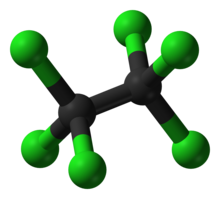
| |

| |
| Names | |
|---|---|
| Preferred IUPAC name
Hexachloroethane | |
| Other names
Carbon hexachloride, Ethane hexachloride, Perchloroethane, Sesquichloride of carbon
| |
| Identifiers | |
3D model (JSmol)
|
|
| 1740341 | |
| ChEBI | |
| ChEMBL | |
| ChemSpider | |
| ECHA InfoCard | 100.000.606 |
| EC Number |
|
| 26648 | |
| KEGG | |
PubChem CID
|
|
| UNII | |
CompTox Dashboard (EPA)
|
|
| |
| |
| Properties | |
| C2Cl6 | |
| Molar mass | 236.74 g/mol |
| Appearance | colorless crystals[1] |
| Odor | camphor-like[1] |
| Density | 2.091 g/mL at 25 °C |
| Melting point | sublimes |
| Boiling point | 183 to 185 °C (361 to 365 °F; 456 to 458 K) |
| 0.005% (22.2 °C)[1] | |
| Vapor pressure | 0.2 mmHg (20 °C)[1] |
| -112.7·10−6 cm3/mol | |
| Hazards | |
| Occupational safety and health (OHS/OSH): | |
Main hazards
|
Probable carcinogen, dangerous CNS depressant |
| NFPA 704 (fire diamond) | |
| Flash point | noncombustible[1] |
| Lethal dose or concentration (LD, LC): | |
LD50 (median dose)
|
4460 mg/kg (rat, oral) 4970 mg/kg (guinea pig, oral) |
| NIOSH (US health exposure limits): | |
PEL (Permissible)
|
TWA 1 ppm (10 mg/m3) [skin][1] |
REL (Recommended)
|
Ca TWA 1 ppm (10 mg/m3) [skin][1] |
IDLH (Immediate danger)
|
Ca [300 ppm][1] |
Except where otherwise noted, data are given for materials in their standard state (at 25 °C [77 °F], 100 kPa).
| |
Hexachloroethane (perchloroethane) is an organochlorine compound with the chemical formula (CCl3)2. It is a white or colorless solid at room temperature with a camphor-like odor.[3] It has been used by the military in smoke compositions, such as base-eject smoke munitions (smoke grenades).
Hexachloroethane was discovered along with carbon tetrachloride by Michael Faraday in 1820. Faraday obtained it by chlorinating ethylene.[4]
- ^ a b c d e f g h NIOSH Pocket Guide to Chemical Hazards. "#0316". National Institute for Occupational Safety and Health (NIOSH).
- ^ "Hexachloroethane". Immediately Dangerous to Life or Health Concentrations (IDLH). National Institute for Occupational Safety and Health (NIOSH).
- ^ Snedecor, Gayle (1999). "Hexachloroethane". In Kroschwitz, Jacqueline I. (ed.). Kirk-Othmer Concise Encyclopedia of Chemical Technology (4th ed.). New York: John Wiley & Sons, Inc. p. 428. ISBN 978-0471419617.
- ^ Faraday, Michael (1859). Experimental Researches in Chemistry and Physics. Taylor and Francis. p. 46. ISBN 978-0-85066-841-4.
